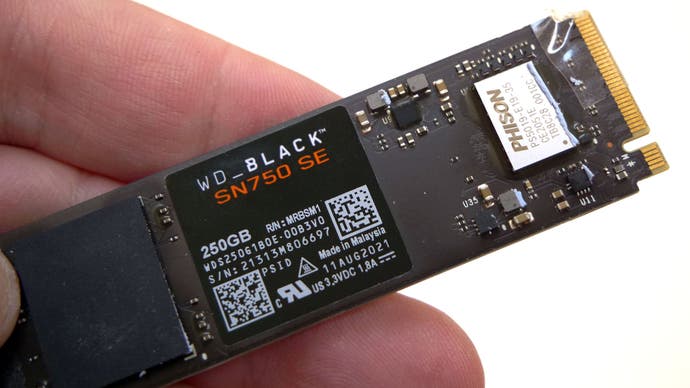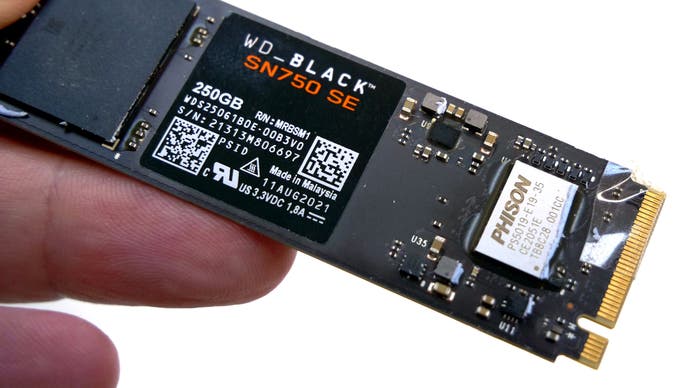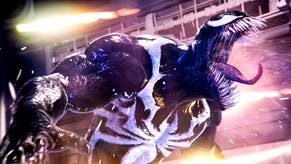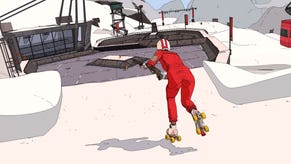DF Weekly: Testing Marvel's Spider-Man 2 on the worst PS5 SSD money can buy
And then we made it run even slower.
There's an embarrassment of riches in the 136th edition of DF Direct Weekly, spread across almost two hours of 'content'. We discuss the good and the bad points of the Modern Warfare 3 campaign and EA's WRC, we spend time talking about how impressive the Switch port of Super Mario RPG is and share impressions on Apple's newly announced M3 processor line-up. However, for this Eurogamer blog, I'm going to talk about what it's like to run Marvel's Spider-Man 2 on the slowest, quantifiably worst PCIe Gen 4 SSD 'upgrade' money can buy.
Long-time readers/viewers of Digital Foundry may recall that back in the day, when the PS5's M.2 bay was enabled, we stacked up the internal storage solution with the best and worst PCI Gen 4 SSDs of the time. The Western Digital SN750 SE 250GB is a bit of a stinker to be honest. At just 3200MB/s of bandwidth, it falls well short of the 5500MB/s demanded by Sony, not to mention the 7000MB/s recommended by Mark Cerny when the PS5 was first revealed. It also lacks any kind of DRAM cache, which isn't helpful. Even so, while slower at transfers, the drive still performed well. It could even run Ratchet and Clank: Rift Apart just fine. Clearly, we needed to up the ante.
- 0:00:00 Introduction
- 0:01:05 News 01: Modern Warfare 3 campaign launches in early access
- 0:20:28 News 02: Apple announces M3 line of Mac chips
- 0:36:58 News 03: Gran Turismo 7 updated with new track, cars, 4-player splitscreen
- 0:43:36 News 04: How does Spider-Man 2 work on the slowest PS5 SSD?
- 0:53:16 News 05: Super Mario RPG previewed!
- 0:58:11 News 06: Switch OLED: does it burn in?
- 1:05:59 News 07: EA WRC: problematic PC performance
- 1:18:31 Supporter Q1: What OLED would you recommend to someone who enjoys both new and old games?
- 1:26:31 Supporter Q2: What are your hopes for the Max Payne remakes’ use of Northlight?
- 1:35:32 Supporter Q3: For retro themed games and collections, what can developers do to improve low-res visuals?
- 1:40:49 Supporter Q4: Some people seem to be rejecting graphical improvements - what are your thoughts?
- 1:49:39 Supporter Q5: Do you think Metroid Prime 4 will skip the current Switch and ship only on the upcoming Switch?
- 1:53:22 Supporter Q6: Is there a market for publishers to release older games without upgrades?
This is where backers of the DF Supporter Program stepped in, pointing out that the rubbish SN750 SE could be limited still further, by physically taping up a selection of the pins on the PCIe interface, reducing PCIe x4 to x1 bandwidth. Remarkably, the drive still works in the PlayStation 5. According to the PS5's internal benchmark tool, this gives the console just 1782MB/s of bandwidth to work with, suggesting that the drive 'might not be fast enough' to play PS5 games seamlessly.
Enter Marvel's Spider-Man 2. Insomniac uses the I/O set-up of the PlayStation 5 to facilitate much faster traversal than prior titles and while I won't spoil the specifics, an earlier mission sees the studio bring back the portal technology of Ratchet and Clank, with a segment that sees Miles Morales not only travelling through New York at full pelt, but also switching between locations using portals. In a kind of ghoulish way, I was curious to see how Insomniac's systems may fail when its challenging technology meets a piece of hardware that's nowhere near the required specifications.
But here's the thing: it still works just fine in the content I tested, the only noticeable difference coming from ultra-fast loading times losing a second or two when starting the game, with some in-game segments heavy on storage lagging a few frames behind - but with no signs of any actual performance drops.


Put simply, even with already curtailed bandwidth savagely cut back, what we saw with Marvel's Spider-Man 2 mirrored the results seen in Rift Apart - and it's at this point that we should probably put solid state storage into context of the entire I/O system within the PlayStation 5 because the amount of bandwidth available to the system is just one component of the entire set-up. We see it all the time on PC, where in games, even SATA SSDs can hold up relatively well against NVMe alternatives in many applications - and where it's often tough to tell the difference between PCIe Gen 3 and PCIe Gen 4 SSDs in the general run of play.
There are two further elements of the PS5's I/O system that should be highlighted and only one is actually to do with the SSD itself - the fact that there are no moving parts. This means that, unlike a mechanical hard drive, there is no head moving around the surface of the disk, seeking out required data. With an SSD, there's effectively instant access to any part of the drive. And perhaps with the kind of data being streamed by the Insomniac engine, massive levels of bandwidth aren't required. Many smaller chunks of data are far more likely to be required as opposed to larger chunks.
The other crucial element is the fact that PlayStation 5's Kraken decompression blocks seem to be doing a hell of a lot of heavy lifting for the new console. Compressed data is streamed from storage, then decompressed via hardware with no real CPU impact whatsoever. We know for sure that Insomniac does a lot of work in optimising its systems to make as much use of this hardware as possible.
So, I was expecting something to break with Marvel's Spider-Man 2 running on an SSD with this poor of a spec, but ultimately, everything seemed to work just fine and I played a couple of hours through with no issues. However, while I suspect that most games will run just fine on just about any kind of PCIe Gen 4 SSD you add to your PlayStation 5, we've now reached the point where drives that meet Sony's required specifications are very, very cheap. There's no need to opt for something cheap and cheerful when drives that meet the 5500MB/s bandwidth requirement are also inexpensive - and with Black Friday just around the corner, expect to see another deluge of deals.

















